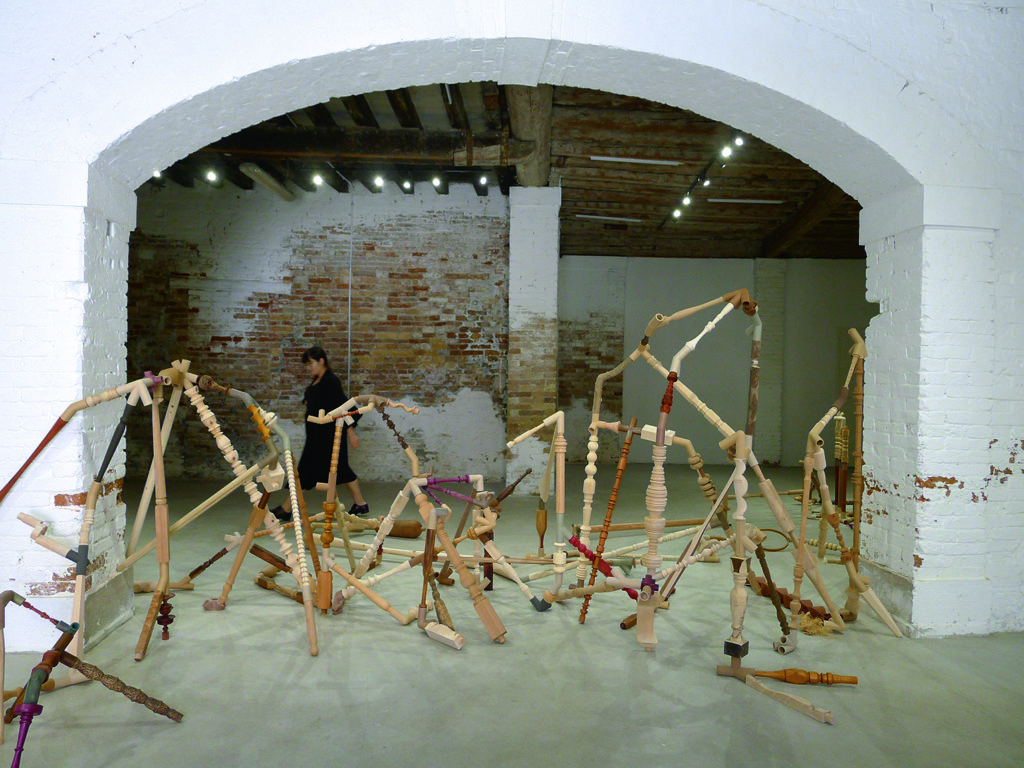It is now, suddenly, seven months since my promise to write in this column about artist Shirley Tse’s Hong Kong pavilion exhibition at the Venice Biennale.* Then, Hong Kong’s large anti-extradition rallies started, and we were seriously side-tracked. Then, the protests morphed into anti-government, anti-China, anti-police rallies and pro-U.S. democracy bill, pro-Uighur, pro-Tibet, and save-PolyU etc street confrontations – over the months, this column has reflected what I witnessed and felt.
Tse’s exhibition is surprisingly relevant to recent events, and belatedly I reflect on her excellent Venice presentation, which she will reprieve in a new Hong Kong iteration at the M+ pavilion in mid-2020. Recently, I wrote a longer art review on Tse’s Venice exhibition, ‘Stakeholders’, in the Hong Kong bi-lingual art magazine, Artomity. Tse’s Venice display comprised two modest, but thoroughly absorbing, installation pieces: in the venue’s outdoor courtyard, Playcourt was an imagined abstracted game of badminton; inside, glimpsed from the courtyard through open doors, was the sprawling installation, Negotiated Differences.
Tse explains that Negotiated Differences is similar to a “rhizome”, a subterranean plant system that expands through roots and shoots from its interconnecting nodes. Tse’s installation uses different species of wood that she has hand-turned on a lathe. The resulting turned wooden spindles are connected using 3-D printed connectors allowing the installation to spread and embody the idea that the different species of wood – or metaphorically, humans, or any intricate entity, will, as Tse explains, “have different weights and the connectors have different angles. I imagine them having to negotiate with each other to arrive at a balance. They’re joined in their fight against gravity.” She explicitly clarifies that, “In human terms this interdependence perhaps starts with individuals who realise they have a stake in something once the connections becomes clear to them.”
Tse’s ideas have particular relevance as the world procrastinates the possibility of its demise due to global warming. The Swedish student and climate activist Greta Thunberg has become the young face of this movement and whose generation will bear the consequences of inaction; her simple message is: “panic!”, because unless we change our behavior, change our capitalist system, and reduce carbon emissions, the planet will heat uncontrollably and agriculture and fishing, at a minimum, will be unable to support the world’s population. Thunberg’s own “stake” has been physically expressed as an action when she began a simple, immensely effective non-violent protest by skipping school and sitting outside the Swedish parliament every Friday. She explains: “If everyone knew how serious the situation is and how little is actually being done, everyone would come and sit down beside us.” *
In Hong Kong, despite the violent evolution of the protests, the government continues to refuse any dialogue with protesters, or alternatively in lieu of its ‘leaderless movement’, with pan-democrat legislators. This refusal to negotiate denies a key motivation of the protest psyche, as Tse has pinpointed: the protesters’ inevitable need to express themselves and “who realise they have a stake in something.” Government’s refusal to talk denies that “stake” to be discussed or negotiated and, in Tse’s words, “to arrive at a balance.” Negotiation is a pivotal tenet of politics and of good governance. Unfortunately, Hong Kong’s executive-led government has, under some definitions, due to its inflexible refusal to open dialogue and negotiate, become tyrannical.
Political and social commentators have proposed that a consequence of the current, serious impasse is that hardcore protesters have resorted to violence. This violence could be expressing the “stake” and frustrations that some young people have about their own political future within the ‘one country, two systems’ framework. Resolution may not be simple, but initially, if the mainland and Hong Kong public both believe there is merit in the “stakes” of ‘one country, two systems’, then government must open dialogue. But, to paraphrase Thunberg, if everyone knew how serious the situation is and how little is actually being done, the public and all legislators would demand, as Thunberg demands, that we “panic” to initiate dialogue. Or, is the continuing violence the only ‘hardcore’ expression of panic that the government will, ironically, allow?
* See Shirley Tse’s Venice Biennale exhibition website: https://vbexhibitions.hk/
* Greta Thunberg, No One is Too Small to Make a Difference, a book of her speeches, 2019







